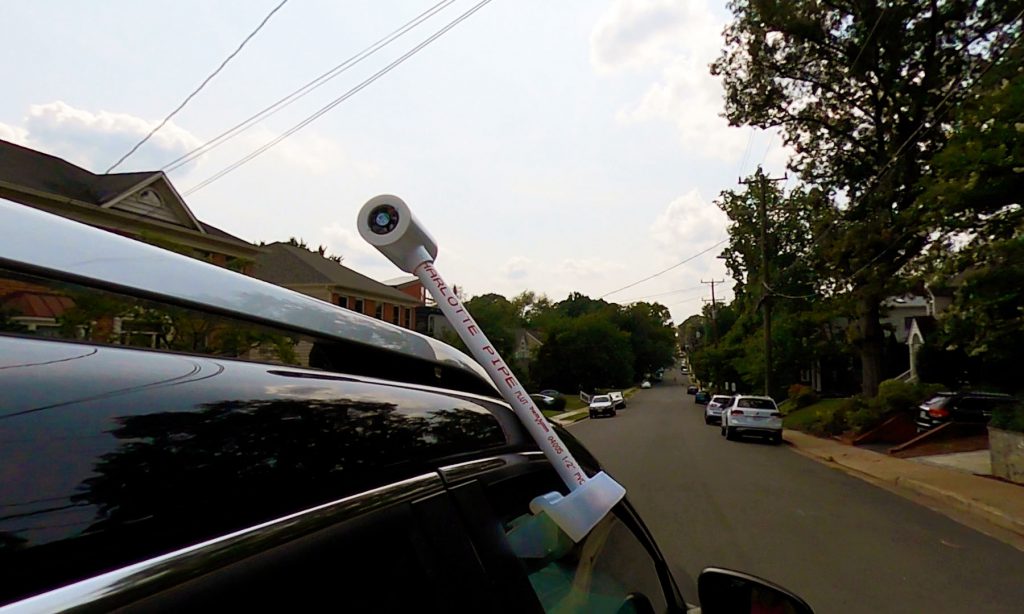Newly released data showing Northern Virginia’s extreme heat spots is prompting Dr. Susan Agolini, Assistant Professor of Biology at Marymount University, to find solutions to alleviate “hot zones” throughout Arlington.
Last summer, Dr. Agolini braved one of the hottest days in July to lead the University’s efforts in collecting temperature data across Arlington County. Teams of Marymount staff, students and volunteers from community organizations traveled several routes as part of the Virginia Foundation for Independent Colleges’ Heat Watch Campaign.
Simultaneously, citizen scientists across the Commonwealth contributed to the statewide data collection effort.
“Over 200 volunteers took part in the Heat Watch Campaign,” said Matt Shank, President of the VFIC and former president of Marymount University. “Volunteers used temperature sensors to traverse their study areas on a hot July 15 day by walking or driving at three standardized times of day — morning, afternoon and evening. These data resulted in high-resolution heat surface maps, revealing temperature variations in our region.”
On Tuesday, VFIC publicly released the data prepared by CAPA Strategies and gathered by Marymount, Virginia State University and 12 other VFIC member institutions that collectively covered more than 300 square miles, from Arlington to Abingdon and Virginia Beach to Winchester.
According to data collected at 3 pm in Arlington, temperatures in the Ballston-Clarendon Courthouse corridor were recorded at the 94.8-degree range. Less than two miles away, the Potomac Overlook Park area appeared to be in the 87.8-degree range, amounting to a seven-degree difference in temperature.
Dr. Agolini explains that “hot zones,” or areas with a lot of concrete and asphalt like the Ballston-Clarendon Courthouse corridor, are hotter because heat is absorbed by these surfaces and then radiated back out into the environment. Areas such as the Potomac Overlook Park area that have more trees, grass or gardens will absorb the heat and not reflect it back, and are therefore cooler.
“I do not think there were any surprises here with regard to what areas were hotter,” Dr. Agolini said. “We know that locations with a lot of pavement and cement are going to be hotter than areas with a lot of trees and green space. The question is what do we do about that?”
Dr. Agolini plans to use this data on hot zones to engage county officials in a discussion about urban planning and the use of potential green solutions, like planting more trees in certain areas or incentives for more community gardens around or on top of buildings.
“I find it really compelling that the benefits of and need for increased space for urban agriculture could actually serve multiple purposes,” Dr. Agolini added. “It would not only provide Arlington residents with the physical and mental health benefits of growing their own food, but it could also have the added benefit of decreasing the impact of heat disparities throughout the county.”
Thanks to a generous contribution by the Virginia Department of Forestry, Marymount will take part in a tree-planting campaign in the fall to help create more green space throughout Arlington.
“Colleges and universities that participated in the Heat Watch Campaign have already put the data generated by the project to good use,” Shank explained. “Students and faculty members have used the data in research projects and presentations. The data has also been used to develop new curricula, as well as implemented in existing labs and lecture classes.”
Marymount Honors student Chandler Eddleton is currently working on a research tutorial with Dr. Agolini that’s focused on the impact of community gardens and global warming. This summer, they hope to continue their collaboration with a more in-depth analysis of the Heat Watch Campaign data to inform ideas for increased community garden spaces.
The Heat Watch Campaign was made possible through the collaboration of CAPA Strategies, Capital One, the Science Museum of Virginia and the Virginia Department of Forestry.






